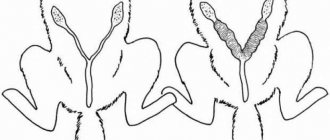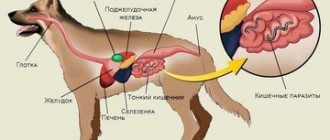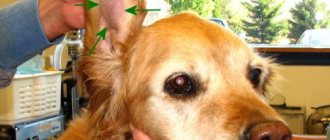Internal bleeding in a dog is an extremely dangerous type of illness. An ordinary owner without veterinary help will not be able to immediately determine what is happening, how serious it is and what caused it. Moreover, if it is strong, then there is very little time to deliver the dog to the clinic; sometimes the count is not even in hours, but in minutes. Possible death.
The cause of blood loss can be not only injuries, but also the consequences of various diseases. Blood enters the abdominal cavity, but cannot leave the body. Depending on the damaged vessels, venous and arterial types are distinguished. The latter are considered the most dangerous.
What is the danger?
Depending on the method and extent of damage, various consequences are possible. This most often depends on the severity of the hemorrhage, duration and measures taken.
Rapid blood loss leads to death within a few hours. However, problems with small vessels can also greatly worsen the dog’s condition. Decreased fluid circulation results in decreased oxygen levels and fewer blood cells. This, in turn, leads to anemia, decreased hemoglobin, and interruptions in heart function. Metabolic processes in the body worsen. The cells begin to gradually die.
Not all lesions are fatal. A minor one will not cause much harm and will be healed by the body on its own, provided that the coagulation parameters are normal. But with active physical activity, the resulting blood clots will displace and bleeding will re-open, leading to increasingly serious complications.
First aid for bleeding
If bleeding in dogs is caused by any serious illness and is internal, it is necessary to urgently consult a doctor, only he will be able to determine the treatment and set of measures to be taken.
If the bleeding is caused by a cut or injury and is external, emergency care is provided depending on the type of bleeding:
- For the venous type, you need to apply a pressure bandage. The material you can use is bandage and cotton wool. It must be applied directly to the wound and bandaged tightly. If help does not appear after 1-2 hours, the bandage should be loosened slightly.
- Arterial bleeding means that the dog is losing blood extremely quickly. In such cases, it is necessary to pull the paw above the cut or wound. You can use anything - a leash, collar, tourniquet or bandage. In the middle of the resulting bandage, you need to insert a stick and twist it clockwise until the bleeding stops. Then you need to urgently call the doctor. If the wound is dirty, you can treat it with an antiseptic, but only around the edges.
- Capillary bleeding can be stopped by applying a tight bandage and ice or something cold on top. After it stops, you can rinse the wound with clean water and lubricate the edges with antiseptics.
While following the above recommendations, remember that you should not leave a tourniquet or tight bandage on for longer than 2 hours - this can lead to tissue necrosis.
The process of blood leaving the lumen of the vascular walls due to a violation of their structural integrity is called bleeding. Blood can flow out in small droplets, flow in a continuous stream, or flow under powerful pressure. Blood loss can be insignificant or measured in liters.
The type of damaged vessel determines the degree and type of bleeding. There are venous, arterial, capillary and mixed bleeding. The appearance of bleeding coincides with the onset of damage factors or remains hidden for several days. In such cases, primary or secondary hemorrhage is distinguished.
There is also a distinction between external and internal bleeding. External hemorrhage is when blood flows freely out. When blood accumulates in a body cavity under pressure, called extravasation, the bleeding will be internal.
More often, dogs are diagnosed with internal hemorrhage, which is dangerous because it cannot be detected for a long time and the pathological process occurs in the initial stages, almost asymptomatically. External bleeding is easier to diagnose and take measures to eliminate it.
It is extremely important for the dog owner to promptly detect the characteristic symptoms of bleeding. In the future, this will help prevent the development of complications and death of the pet.
Causes
The reason to start is any deformation of internal tissues. However, scientists have identified several of the most characteristic reasons:
- Injuries . Traumatic injury is caused by any blow or fall. Depending on the affected organ and the degree of damage to a particular ruptured vessel, blood loss can be slow or rapid. In the second case, most often they do not have time to save the dog. Small vessels can clog on their own, but you shouldn’t rely on this completely. The more time has passed since the injury. The less chance of survival the animal has. The spleen, kidneys and liver are mainly affected. If the kidney tissue or bladder is affected, then the outpouring of urine into the abdominal cavity increases. Uterine hemorrhages also belong to this type.
- Tumors appear in the stomach of older dogs. Shepherds are especially susceptible to them, although representatives of other breeds are not safe. Depending on the size and growth rate of the tumor, there may be rapid or chronic blood loss. Chronic occurs irregularly when growing tissue damages small vessels. Gastric and intestinal bleeding is extremely dangerous due to the severe limitation of treatment methods. Pills, food and water are strictly prohibited, nutrients and medications can only be given through an IV.
- Hematomas . They exist primarily on the spleen. They are a consequence of injury or nodular tissue regeneration when too much of it grows. Damaged vessels accumulate blood inside the organ so that the site of the hematoma is indistinguishable from the neoplasm, which becomes a problem in diagnosis.
- Coagulopathy or bleeding disorder . This disease occurs mainly in young dogs and puppies. The main danger is the impossibility of stopping without external influence. Until measures to increase coagulation are applied, for example, fresh frozen plasma, vitamin K and other drugs, fluid will flow into the peritoneum. The onset of the process is provoked by severe poisoning with rodenticides that prevent clotting. In such cases, hemorrhages in the subcutaneous layers are also observed.
Why is my dog bleeding from his anus?
There are many reasons why dogs may bleed from the anus. Some of them can be called relatively harmless, while others require serious medical intervention. Of course, the best option would be to take your pet to the veterinarian, but at first you can try to determine why the leak appeared on your own.
Did you know? Many diseases in dogs are identical to human diseases, which is why these animals are often used as models in evolutionary biology.
It is important to determine how serious the situation is. If the blood coming out with the stool is scarlet in color, then there are some problems with the lower parts of the gastrointestinal tract. When the stool as a whole has a tarry black color, this may indicate internal bleeding, that is, the blood had time to clot while moving through the intestines. There are a number of other symptoms that can help determine why your pet suddenly started bleeding from the butt.
Mechanical damage
First of all, try to analyze whether your dog has suffered any serious injuries recently. Perhaps someone hit him hard or he was hit by a car. As a result of such mechanical damage, as a rule, the dog, during bowel movements, comes out with blood clots along with feces, resulting from damage to internal organs.
Mechanical damage also includes injury caused to the mucous membrane of the stomach or intestines by a sharp bone, so veterinarians strongly do not recommend feeding four-legged pets with such food. This could be any other object that accidentally gets into the stomach (a stick, a stone, etc.). A sign of this type of damage is black stool.
Parasite infestation
If, when your dog defecates, the stool has a normal consistency, but you can see blood in it, you need to check if your pet has parasites. Often, infection with helminths occurs asymptomatically. A good appetite with significant weight loss can be a signal. In an advanced state, the disease progresses more actively - parasites can begin to crawl out through the anus, the dog develops severe itching in the anus, and begins to “ride on its butt.”
Haemorrhoids
If a dog has had a difficult birth as an adult or suffers from frequent constipation, it may begin to develop varicose hemorrhoids. Hard feces, moving through the anus, can injure them, resulting in intense bleeding. A large content of fresh blood can be observed in bowel movements, and this occurs regularly and as a result can lead to anemia. You should also consult a doctor immediately because in a neglected state, inflammation or necrosis may develop on the walls of the prolapsed rectum, which will require surgical intervention.
Gastrointestinal diseases
Various diseases of the gastrointestinal tract, such as ulcers, pancreatitis, gastroenteritis, etc., most often cause a dog to bleed from the anus. Only a doctor can determine this based on the diagnostic tests performed.
Ulcerative bleeding with intensive development is accompanied by vomiting mixed with blood. If the internal blood loss is small, there may be no vomiting, but the blood is converted under the influence of intestinal enzymes, and the feces will have a black color and a mushy consistency.
Important! Ulcers can occur as a result of treatment with non-steroidal drugs that damage the gastric mucosa, so they should only be given on the recommendation of a veterinarian.
Infectious gastroenteritis is no less dangerous. Most often, the disease develops in puppies if the owners do not follow the rules for keeping and feeding the animal. During illness, the mucous membrane of the animal's gastrointestinal tract swells, which is easily injured by food masses, as a result of which feces are released with blood. Moreover, the flow may be profuse, but the sparser it is, the worse, since the disease will still progress, and the animal may get to the veterinarian much later. In the later stages, diarrhea with blood appears, the animal tries to retire, stops eating, and groans periodically.
Tumors
Various benign and malignant tumors close the lumen of organs as they grow. Feces, moving through them, cause bleeding, in which the admixture of blood is visible to the naked eye. In case of cancer, in this case, all that remains is to maintain the vitality of the animal or euthanize it. If the tumor is benign, the dog can still be saved, but only if you consult a doctor in a timely manner. Regular and timely examination of your pet will help eliminate this situation.
Did you know? In Ancient Egypt, after the death of a dog, the family in which it lived went through mourning without touching food for a long time.
Other reasons
There are a number of other reasons that can cause bleeding in a pet. Often, owners, seeing that an animal is not feeling well, prefer to treat it themselves, instead of turning to a veterinarian. Medications intended for humans are not always suitable for animals; their composition or increased dosages can only worsen the animal’s condition. Even the most seemingly harmless aspirin with an excessive dosage can provoke gastric or intestinal bleeding, causing the dog to bleed from the anus. This is the so-called medicinal diarrhea.
Other reasons include the following:
- poisoning with toxic substances. Such cases also occur. For example, if rodent baiting is carried out in a private home and the dog accidentally tries a chemical, it can be seriously poisoned. Such substances contain coumarin, which causes severe intoxication;
- an atypical form of rabies accompanied by gastroenteritis;
- piroplasmosis is a disease caused by an animal tick entering the body. Symptoms include lethargy, loss of appetite, the appearance of blood in the urine and later in the stool, and vomiting.
In any case, contacting a veterinarian should be done immediately. This is especially true for puppies, whose immune system is just beginning to develop and the body is not able to resist the disease for a long time.
Symptoms
It is quite difficult to accurately determine the presence of internal bleeding; most symptoms appear when the condition can already be called critical. However, you can actually detect that something is wrong with your pet quite quickly if you watch him carefully. Particular attention to the behavior and well-being of the dog should be paid if he has recently received any injury or blow.
Symptoms include:
- Rapid breathing.
- Weakness.
- Fainting.
- The appearance of subcutaneous hemorrhages.
- Pale mucous membranes.
- Blood inclusions in stool.
- Vomiting.
- Increasing abdominal volume.
- Constant strong thirst.
It is impossible to accurately determine the problem and make a diagnosis on your own. An examination by a veterinarian and possible urgent assistance are required. Having noticed the first signs, don’t wait for things to improve. Sometimes even an extra half hour of delay can cost the dog his life.
First steps to help
If your dog has a nosebleed, calm down and think about what to do to stop it. Panic will not only not help, but will also make the situation worse.
Four-legged friends read the emotions of their owners well and can become seriously worried. An even greater jump in blood pressure will negate all your efforts, so take a break from analyzing the possible causes.
Lying position and cold on the bridge of the nose
Lay or sit your pet down with his head down. This position will prevent blood from refluxing into the throat and make breathing easier.
Apply ice, snow, a cold water bottle, or frozen meat wrapped in a thick cloth to the bridge of your nose. The cold will constrict the blood vessels and stop blood loss.
Help with poisoning
If you are sure that your pet has been poisoned by rat poison, induce vomiting with saline solution. In addition to washing, it is recommended to give activated carbon or another sorbent. After cleansing the stomach and intestines, be sure to contact a veterinary clinic. To neutralize the poison, you will need an injection of Vikasol.
Help with head injury
In case of injury, it is necessary to limit any movements of the animal as much as possible, placing it on its stomach. Make sure his head is on his front paws. Use cold and call a veterinarian. You will not be able to cope with internal bleeding on your own.
What to do if you have heatstroke
If he overheats, take your dog to a cool place and provide him with enough oxygen by opening the windows. Wet the fur or cover it with a damp cloth to reduce body temperature. In addition to a cold compress, offer your pet cool, but not ice-cold, water.
Diagnostics
The main diagnostic method when dealing with such symptoms is a physical examination of visible symptoms and a study of the medical history. This will allow you to quickly understand what is going on in case of a critical condition and take action. If time permits, a number of studies are carried out to accurately establish the cause and consequences of what happened:
- An abdominal ultrasound will help determine the presence of accumulated fluid, bruises, or tumors.
- X-rays are performed for the same purpose as ultrasound, but their results are more difficult to decipher.
- General and biochemical analysis.
- Puncture of the stomach fluid will allow you to find out the composition of the secreted fluid and the possibility of clotting.
If urgent surgical intervention is not required, after all the studies a diagnosis is made and a treatment regimen is developed.
Do I need to contact a veterinarian?
Excessive blood loss is fraught with serious consequences, so do not neglect the help of a veterinarian. Even a small leak can accompany a dangerous systemic disease, so do not make hasty conclusions until the diagnosis is established.
Diagnosis at home or in clinic
Before contacting the veterinary clinic, try to collect as much information as possible about what happened. Record all alarming symptoms, analyze the likelihood of injury and poisoning, and do not forget to take with you the instructions for all medications your pet takes.
Remember that one of the most alarming signs is paleness of the mucous membranes, which can lead to death from excessive blood loss. In such a situation, you should seek help even at night, without thinking about making an appointment in advance. Four-legged patients in serious condition are always accepted without a queue.
If you were unable to stop the bleeding, and your pet’s condition continues to worsen, do not waste time on the road and call a doctor directly to your home. If there is a serious threat to the dog’s life, they may be taken to the hospital.
Treatment
Treatment is carried out comprehensively, the chosen therapy depends on the condition of the dog and the causes of the problem.
The most commonly used methods are:
- The first thing that needs to be done is an intravenous infusion of fluid, which will help reduce the state of shock and improve the functioning of the internal organs.
- Abdominal ligation increases intra-abdominal pressure. A tight bandage is placed on the abdomen.
- Oxygen therapy is necessary for large blood loss. This is the first procedure that is carried out if external signs indicate a deficiency. It is served through a special mask.
- Painkillers and painkillers are used to calm and stabilize the animal. Otherwise, it may harm itself.
- The use of vitamins K can improve clotting.
- Emergency surgery is often the only way to save an animal in poor condition.
Why shouldn't you try to solve the problem yourself? Without special equipment and examination, you will not be able to accurately determine the cause of the problem and its extent. Therefore, at the slightest suspicion of internal bleeding, you should contact a veterinarian.
Internal bleeding after spaying a dog
Sterilization of dogs is in increasing demand, especially in urban areas. Despite its many advantages, the procedure is associated with some risks, even though it is performed in a medical facility by qualified specialists. One possible complication is internal bleeding.
Internal bleeding after spaying a dog
Occurs after sterilization of a dog. The most dangerous are bleeding from the vessels of the spermatic cord. The cause may be errors during surgery, or poor general condition of the dog’s body.
Such bleeding is divided into primary and secondary. The latter appears a few hours or days after the operation. Primary occurs directly during surgery.
Bleeding can be determined by increasing signs of anemia. Venous blood in small volumes continues to be released from the vessels of the scrotum for a long time. The problem can be determined using laboratory tests. There is also a change in the state of the blood, a decrease in hemoglobin and red blood cells occurs.
During treatment, the animal is given rest and plenty of cool water is given. Therapy includes the use of antibiotics. Calcium chloride is administered. If blood loss is significant, a blood transfusion is performed. To prevent various infections and complications, various antibiotics, sulfonamide drugs or Vicasol are prescribed.











